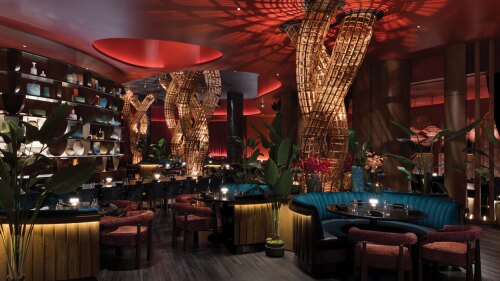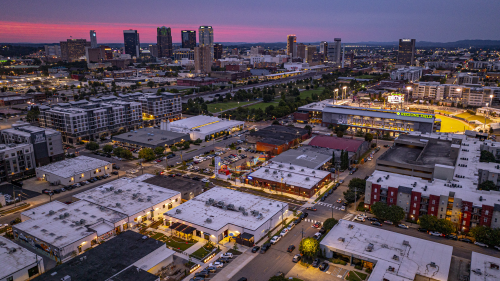Property Types
Hotels and Resorts
The hotel industry in the United States faces complex challenges in 2025, according to Jan Freitag, national director of hospitality analytics for the CoStar Group. During the “State of the U.S. Hotel Industry” presentation at the ULI 2025 Spring Meeting in Denver, Colorado, Freitag highlighted the challenges facing the hotel business amid macroeconomic uncertainty.
Once a sprawling expanse of uncharted land, Las Vegas, Nevada, has evolved into the entertainment capital of the world, a gaming super-hub, and a premier destination for sports. This remarkable transformation didn’t happen overnight; it stemmed from decades of strategic planning, investment, and visionary zoning recommendations.
Las Vegas is unlike any other place in America. Each year it draws more than 40 million visitors to the dazzling casinos and hotels that “turn night into daytime”—and transform the city into a glittering jewel in the desert. With 164,000 hotel rooms, Las Vegas is the largest hospitality market in the U.S.—outpacing Orlando, Florida, the next biggest market, by approximately 15 percent, according to JLL.
Industrial
Standing in the shadow of Regions Field and within earshot of Railroad Park, Birmingham’s Urban Supply hints at what the next chapter of downtown life could look like. Once-quiet brick warehouses are being steadily reimagined into patios, storefronts, and gathering spaces along a new pedestrian alley. Early tenants have begun to open their doors, and programming is slowly bringing people into the district. While the project is still in its early stages, the framework is in place for a vibrant hub that will grow block by block in the years ahead.
What trends are shaping the future of the industrial sector? Four experts from ULI’s Industrial and Office Park Development Council talk about the industrial submarkets and property types that offer the greatest opportunities, challenges developers face in bringing new projects to market, ways artificial intelligence and emerging technologies are reshaping the sector, tenant priorities, and other key trends.
After a quiet first half of 2024, CMBS originations increased 59 percent in Q3 on a year-over-year basis, according to the Mortgage Bankers Association’s Quarterly Survey.
Mixed-Use
From open spaces in Singapore and a remote part of China, to revamped malls in the Philippines and Australia, to a greenbelt that gives vertical lift to apartment living, the five winners of the 2010 ULI Awards for Excellence: Asia Pacific all feature the latest technology, sustainable design, and artistic innovation. They not only enhance their own value, but also engage visitors and improve the quality of life for the millions who experience these projects.
In 2009, the median price of an existing single-family home in the United States declined by 12.5 percent, the largest single-year drop since the National Association of Realtors began tracking the number in the late 1960s. But there were pockets of stable values and even rising home prices in every major metropolitan area across the country. The location of these stronger neighborhoods tended to depend on the traditional strengths of the metropolitan area as a whole.
As the economy finally—perhaps—emerges from the prolonged recession, it is difficult to imagine a future in which the United States continues to lead the world— technologically, innovatively, and economically. This becomes particularly more difficult in the face of the barrage of reports about China and India materializing as the next world powers.
Multifamily
As congregations across North America grapple with shrinking membership and aging facilities, a new opportunity is emerging: transforming faith-owned land into affordable housing and community-serving spaces. At the 2025 ULI Fall Meeting in San Francisco, panelists in the session “Spiritual Brownfields: Declining Congregations and Opportunities for Housing on Faith-Owned Land” explored how churches and developers are partnering to bring mission-driven housing to underused sacred sites.
At the 2025 ULI Fall Meeting in San Francisco, leaders from across the development and construction industries discussed how they are adapting to a volatile yet stabilizing housing landscape in a session called “Report from the Field: Wrestling with the Cost of Housing Construction.” Despite headlines about tariffs, labor shortages, and inflation, the panelists agreed that the cost environment has settled into what one called a “new normal.”
A panel of insiders reveals what’s true—and false—about the housing crisis and how to fix it.
Office
A $295 million shared education and research facility for four universities in downtown Portland, Oregon, is intended to address a long list of objectives in one facility. Read about the many opportunities for both physical and financial savings created by co-locating programs from the universities, and the method devised to allocate space annually among the facility’s constituent institutions.
Pittsburgh, Pennsylvania—a city that was once the butt of jokes—now offers numerous opportunities for developers. Spurred by growth in the medical, education, financial services, and computer software industries, downtown office rents are expected to rise 7.5 percent this year—more than triple the national average. Read what advice ULI insiders have for those who want to enter this market.
As scientists from a variety of disciplines share knowledge in pursuit of new treatments, municipal governments pool resources with the private sector to create biotechnology clusters, universities team with nonprofits, and nonprofits work with for-profit firms to speed the “bench to bedside” process. Read about ten projects that take an innovative approach to fostering interaction and creativity.
Residental
Ferris wheels, roller coasters, and the Florida economy—they are all famous for their ups and downs.
Members of ULI’s Master-Planned Communities Council discuss factors that homebuyers look for in communities; ways that developers are partnering to enhance access to retail, health care, education, and other services; strategies for fostering a sense of community among residents; and other trends.
In an excerpt from his 2013 John T. Dunlop Lecture, J. Ronald Terwilliger suggests society should focus less on subsidizing higher-income homeowners and more on helping lower-income renters, as well as low-wealth homebuyers.
Retail
For decades, civic leaders have tried to revitalize Market Street, San Francisco’s central thoroughfare, only to see their efforts founder. “I sometimes call it the great white whale of San Francisco,” says Eric Tao, managing partner at L37 Development in San Francisco and co-chair of ULI San Francisco. “Every new mayor, every new planning director, every new economic development director has chased that white whale.” This year, however, an international competition of ideas hosted and run by ULI San Francisco, with support from the ULI Foundation, generated fresh momentum for reimagining the boulevard. The competition drew 173 submissions from nine countries and sparked new conversations about the future of downtown San Francisco.
The OAK project began in 2009, when a development firm set their sights on the corner of Northwest Expressway and North Pennsylvania Avenue, the state’s most important and busiest retail intersection. As the region’s only parcel capable of supporting a vertically integrated project of this scale and density, that land represented an opportunity to create something truly special.
As aging retail continue to evolve, one increasingly popular trend has been to redesign malls as town centers—recalling a time when such commercial districts were the heart and soul of a community. Mall–to–town center retrofits are emerging throughout the nation, especially in suburban communities, where pedestrian-friendly, mixed-use environments are highly attractive to millennials now raising families.



















